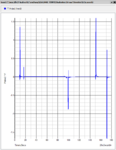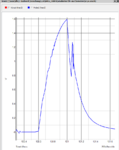deniz88
Member level 2
Hi,
i should measure very fast changing signal with ADC, but ADCs has very narrow input voltage range at the high frequencies,
signal peaks i need to measure is between 10V to -5V. Signal looks like on the following photos.


it needs ADC like around 30mhz i guess, and they can not measure wide analog input ranges. they measure 2V input range . I thought to use opamp voltage scale, would it be accurate enough, to zip voltage to 1V?
would you suggest any other method?
best regards
i should measure very fast changing signal with ADC, but ADCs has very narrow input voltage range at the high frequencies,
signal peaks i need to measure is between 10V to -5V. Signal looks like on the following photos.


it needs ADC like around 30mhz i guess, and they can not measure wide analog input ranges. they measure 2V input range . I thought to use opamp voltage scale, would it be accurate enough, to zip voltage to 1V?
would you suggest any other method?
best regards